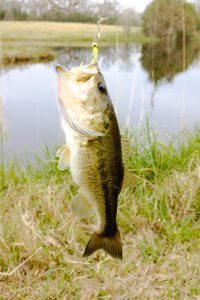Striped Bass Habitat Facts and Information

Catching stripers fishing tips
Striped Bass inhabit the same general waters as largemouth bass, except stripers prefer rocky bottomed lakes and open water. They’re often found in deep, clear impoundments with water temperatures in the mid 70°F’s/21°C+.
Striped Bass are powerful fish and they enjoy the surf. But this is not a very swift fish nor is it graceful. At times you can often see them swirl conspicuously at the surface or splash in pursuit of baitfish.
During the first 2 years of their life, they live mostly in small groups. They don’t form into schools until at least their third year. However, the rules for schooling are not that simple.
- Striped Bass that weigh 30 or more pounds are more likely to swim alone or with a partner, but seldom in schools. When it’s time to migrate, the schools become bigger with larger fish in the pack.
Striped Bass feeding habits
The Striped Bass are a voracious fish that feed on a wide variety of prey fish including alewife, anchovy and croakers to name a few. Striped Bass feeding follows a standard pattern. They gorge on a particular prey, as do most bass, but then after they’ve gorged themselves, they avoid eating for a while before repeating the pattern again.
In estuarine situations the Striped Bass hunt and feed at night because that’s when the sea worms come out and are the most plentiful source of food.
Night time is the most productive time for stripers.
Most larger Striped Bass avoid strong sunlight by sinking to the bottom during the day. This is not a feature of just Striped Bass either. Most freshwater bass avoid direct sunlight.
Trolling for Stripers
- Places like Cape Cod are very effective for catching striper bass.
- The time for trolling stripers is just after sunrise.
The Striped Bass is an inshore fish that rarely travel more than a few miles from the coast. Although they can be found as much as 60 miles/97 kilometres from the coast when migrating, you’re best to focus your efforts on the inshore areas.
In fact, you don’t even need a boat to catch Striped Bass.
They can be caught by casting from a dock or from a rocky outcrop.
In some rivers, good numbers are caught so far upstream that make it likely they remain there the year round.
This can be found in the Alabama river system. It’s not uncommon to catch Striped Bass weighing as much as 40 lbs/18 kgs, some 300 miles/483 kilometers from the ocean.
Best places to fish for stripers
Striped Bass are found along the shoreline until spawning season.
The best places to find stripers outside of this time are
- along sandy beaches
- in shallow bays
- along rocky stretches
- over submerged or partially submerged rocks and boulders
- at the mouths of estuaries
When the tide is high, Striped Bass often lie on a bar and when the tide falls, they drop down into the troughs or move farther out. They also prefer the cover of floating rockweed.
Fishing for striped bass from the shore
The best spots are
- along rocky shores are in the surf and in the wash of breaking waves behind off-lying boulders, or
- where a tidal current flows most swiftly past some jutting point
Fishing Estuaries
In the mouths of estuaries they’re likely to hold to the side where the current is the strongest, and in the breakers out along the bar on that side.
In shallow bays, they often pursue small fry among the submerged sedge grass when the tide is high, dropping back into the deeper channels on the ebb. And they frequent mussel beds, both in enclosed waters and on shoal grounds outside, probably because these are likely to harbor an abundance of sea worms.
Water Temperature
Striped Bass prefer the temperature range from 70°F/21°C down to 43°F/6°C. When the temperature falls, they withdraw to warmer waters or they may just lie on the bottom in a more or less sluggish state. Temperatures above 80°F/27°C will result in their death.
Striper Fishing Rods
These fish can grow big and heavy – 50lbs so be prepared. You need a heavy-duty rod.
For saltwater conditions, make sure it’s a saltwater rod that’s between 6.5 to 7.5 feet/2.3 meters long.
Either a Daiwa Coastal inshore saltwater rod or an Abu Garcia Ambassadeur will do the job.



